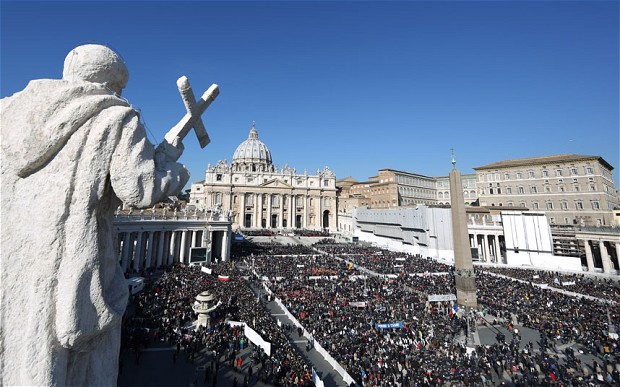Vatican City
Map Page 1131
Area .273 square mi (.44 square km)
Population 911 (2003)
Highest Point Vatican Gardens 252.6 ft (77 m)
Lowest Point Saint Peter's Square 62.4 ft (19 m)
GDP per capita not available
Primary Natural Resources none.
THE STATE OF VATICAN City is the world's smallest independent state. This tiny city situated on a hill in Rome, ITALY, is the capital of the Roman Catholic Church and holds the residence of the pope. Only around 900 people live in Vatican City, but millions of Roman Catholics from all over the world travel each year to visit St. Peter's Basilica and gaze at the artistic treasures.
The Holy See refers to the central government of the Roman Catholic Church. It is the supreme authority of the church, and places the pope as the bishop of Rome and leader of the College of Bishops. The Holy See has characteristics of a state in the rule of international law, and members can sign treaties, receive international diplomats, and be part of international organizations. The Vatican City state and the Holy See are united through the pope as head of state. The pope holds full judicial, legislative, and executive powers in Vatican City.

The history of Vatican City can be traced to Roman times where, originally, summer villas were constructed on Vatican Hill. Caligula built his private circus in the area, and in 65 C.E., the Romans reportedly sacrificed Christians in the Circo Vaticano. Saint Peter, the Roman Catholic Church's first pope, was killed on this spot by the Romans. Around 100 years after his death, a monument was built for Saint Peter, and between 324 and 326, Emperor Constantine ordered a basilica to be built above Saint Peter's tomb.
The original basilica stood for over 1,000 years. However, as the decades passed, the building fell into disrepair. The old basilica was ultimately destroyed along with the beautiful art inside the church. For 150 years, the new basilica was constructed with the aid of some of the world's most recognized artists. Giacomo della Porta, Bramante, Raphael, and Michelangelo were among the many. Michelangelo, at the age of 72, designed the 390 ft (119 m) dome, which can hold up to 60,000 people in the interior.
From the 8th century through the 19th century, the Roman Catholic popes controlled the papal states, a territory that expanded across central Italy. In 1860, Victor Emmanuel's army gained control of these states, which left only Rome and the surrounding coastal sections under the pope's control. During the 1870s, Napoleon III occupied Italy but was eventually forced out by Emmanuel's army. Emmanuel declared Rome the capital of Italy. However, Pope Pius IX refused to recognize the kingdom of Italy, and for over 50 years, the Vatican disputed the legitimacy of rule throughout Italy. During this period, Vatican City did not officially exist, but members of the Holy See maintained diplomatic relations.
In the 1920s, the Italian dictator Benito Mussolini worked with the papal authorities in the creation of an independent papal state. In 1929, the Lateran Treaty was signed which recognized the sovereignty of the Holy See and the establishment of the state of Vatican City. The relations between the Italian government and the papal state were defined through a concordat, and financial compensation was granted for the losses in 1870. In 1984, a revised concordat was signed, which declared Roman Catholicism as the primary religion in Italy.
In 1954, Vatican City was placed under the protection of the La Haye Convention. Through this act, all of the state's cultural goods are safeguarded in case of a military conflict. Overall, the Vatican's treasures are considered possessions of humanity and portray the rich history of the Roman Catholic Church and Vatican City that spans for almost 2,000 years.